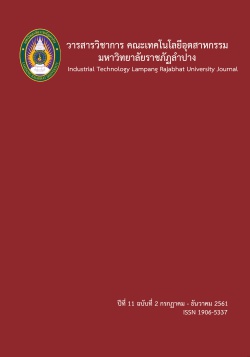The Role of Water in the Synthesis of Fly Ash-Based Geopolymer
คำสำคัญ:
Fly Ash Based Geopolymer, Compressive Strength, Apparent Densityบทคัดย่อ
Water has played an important role in controlling geopolymerization and thus mechanical properties of final geopolymer products. Effects of internal water and atmospheric water on formation of fly ash-based geopolymers and their properties were systematically studied in this research. The initial water amount was varied from 29 to 44 wt%. To investigate the effect of the atmospheric water, curing was designed into 3 successive steps. The samples were first activated at 60 °C in a water saturated-atmosphere for 24 h. Then they were cured at 40 °C for 3 days in two atmospheres; water saturated- or open, prior to curing at 40 °C in an open atmosphere for another 3 days. Microstructure was examined using a scanning electron microscope. Porosity and apparent density were measured following ASTM C 642-06. The results showed that porosity of the samples increased with increasing the initial water content. The initial water content, however, had only minor effect on the apparent density. Curing in the water saturated-atmosphere resulted in a significantly improved compressive strength possibly due to the milder water evaporation. Compressive strength increased with decreasing the initial water contents according to lowered porosity contents. In conclusion, the samples with 29 wt% water content cured in the water saturated - atmosphere showed the highest compressive strength of 34 MPa. This geopolymer paste showed promising potential in construction industry as a cement paste replacement.
เอกสารอ้างอิง
Ayuso, E. A., Querol, X., Plana, F., Alastuey, A., Moreno, N., Izquierdo, M., Bzrra, M. (2008). Environmental, physical and structural characterization of geopolymer matrixes synthesized from coal (co-) combustion fly ashes, Journal of Hazardous Materials, vol. 154, pp 175-183.
Bohlooli, H., Nazari, A., Khalaj, G., Kaykha, M. M., & Riahi, S. I. (2012). Experimental investigations and fuzzy logic modeling of compressive strength of geopolymers with seeded fly ash and rice husk bark ash, Composites: Part B, vol. 43, pp 1293-1301.
Chindaprasirt, P., Chareerat, T., & Sirivivatnanon, V. (2007). Workability and strength of coarse high calcium fly ash geopolymer, Cement & Concrete Composites, vol. 29, 224-229.
Chindaprasirt, P., Jaturapitakkul, C., Challe, W., & Rattanasak, U. (2009). Comparative study on the characteristics of fly ash and bottom ash geopolymers, Waste Management, vol. 29, pp 539-543.
Ferone, C., Colangelo, F., Cioffi, F., Montagnaro, F., & Santoro, L. (2011). Mechanical performances of weathered coal fly ash based geopolymer bricks, Procedia Engineering, vol. 21, pp 745-752.
Görhan, G., and Kurklu, G. (2014). The influence of the NaOH solution on the properties of the fly ash-based geopolymer mortar cured at different temperatures, Composites:Part B, vol. 58, pp 371-377.
Guo, X., Shi, H., & Dick, W. A. (2010). Compressive strength and microstructural characteristics of class C fly ash geopolymer, Cement & Concrete Composites, vol. 32, pp 142-147.
Izquierdo, M., Querol, X., Phillipart, C., Antenucci, D., & Towler, M. (2010). The role of open and closed curing conditions on the leaching properties of fly ash-slag-based geopolymes, Journal of Hazardous Materials, vol 176, pp 623-628.
Jaarsveld, J. G. S., Deventer, J. S. J., & Lukey, G. C. (2002). The effect of composition and temperature on the properties of fly ash- and kaolinite-based geopolymers, Chemical Engineering Journal, vol 89, pp 63-73.
Joseph, B., & Mathew, G. (2012). Influence of aggregate content on the behavior of fly ash based geopolymer concrete, Scientia Iranica A, vol 19(5), pp 1188-1194.
Kumar, S., & Kumar, R. (2011). Mechanical activation of fly ash: Effect on reaction, structure and properties of resulting geopolymer, Ceramics International, vol. 37, pp 533-541.
Mustafa, A. M., Bakri, A., Kamarudin, H., Hussain, M. B., Nizar, I. K., Zarina, Y., & Rafiza, A. R. (2011). The Effect of Curing Temperature on Physical and Chemical Properties of Geopolymers, Physics Procedia, vol. 22, pp 286-291.
Nazari, A., Bagheri, A., & Riahi, S. (2011). Properties of geopolymer with seeded fly ash and rice husk bark ash, Materials Science and Engineering A, vol. 528, pp 7395-7401.
Panias, D., Giannopoulou, I. P., & Perraki, T. (2007). Effect of synthesis parameters on the mechanical properties of fly ash-based geopolymers, Colloids and Surfaces A:Physicochem. Eng. Aspects, vol. 301, pp 246-254.
Rajamma, R., Labrincha, J. A., & Ferreira, V. M. (2012). Alkali activation of biomass fly ash-metakaolin blends, Fuel, vol. 98, pp 265-271.
Rattanasak, U., & Chindaprasirt, P. (2009). Influence of NaOH solution on the synthesis of fly ash geopolymer, Minerals Engineering, vol. 22, pp 1073-1078.
Ryu, G. S., Lee, Y. B., Koh, K. T., & Chung, Y. S. (2013). The mechanical properties of fly ash-based geopolymer concrete with alkaline activators, Construction and Building Materials, vol. 47, pp 409-418.
Somaratna, J., Ravikumar, D., & Neithalath, N. (2010). Response of alkali activated fly ash mortars to microwave curing, Cement and Concrete Research, vol. 40, pp 1688-1696.
Sukmak, P., Horpibulsuk, S., & Shen, S. L. (2013). Strength development in clay-fly ash geopolymer, Construction and Building Materials, vol. 40, pp 566-574.
Temuujin, J., Riessen, A., & Williams, R. (2009b). Influence of calcium compounds on the mechanical properties of fly ash geopolymer pastes, Journal of Hazardous Materials, vol. 167, pp 82-88.
Temuujin, J., Williams, R. P., & Riessen, A. (2009a). Effect of mechanical activation of fly ash on the properties of geopolymer cured at ambient temperature. Journal of Materials Processing Technology, vol. 209, pp 5276-5280.
Tho-in, T. I., Sata, V., Chindaprasirt, P., & Jaturapitakkul, C. (2012). Pervious high-calcium fly ash geopolymer concrete, Construction and Building Materials, vol. 30, pp 366-371.
Vora, P. R., & Dave, U. V. (2013). Parametric studies on compressive strength of geopolymer concrete, Procedia Engineering, vol. 51, pp 210-219.
Xie, J., & Kayali, O. (2014). Effect of initial water content and curing moisture conditions on the development of fly ash-based geopolymers in heat and ambient temperature, Construction and Building Materials, vol. 67(A),
pp 20-28.






